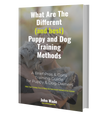 Loading... Please wait...
Loading... Please wait...- Home
- Dog Training (eBooks)
- The Beautiful Balance - Dog Training with Nature's Template
Product Description
The Beautiful Balance - Dog Training with Nature's Template™
- 29 pages - Available for Immediate Download in PDF format - Plus Another 35 Pages of Bonus Material - on how to train your dog to walk on a leash without pulling and to come (20 pages), how to stay on a mat (6 pages) and how to meet people calmly (9 pages) - NO MATTER WHAT!
This book is what you need to know before you train a dog. Traditional dog training jumps much too quickly into the hands on part of training. The truth is the what to do is far easier and success happens much faster when a dog owner learns how their dog sees the world, how it determines who is the teacher and who is the student. With this information there is no need for treats, no need to teach geometric patterns around pylons, how to stay for a few seconds while being stared at. These things do not keep dogs off the kitchen table or our guests. If you want a dog that truly comes when it's called, heels on a loose leash no matter what, knows how to meet people and much more this is the place you should start. It's a short easy read and will be the best money you'll ever spend on your dog.
- What is a Trained Dog Anymore? – Hard to Find One Isn’t It!
- Dog Training Philosophies - The Good – The Bad – They Ugly
- Nature’s Template ™ - the Beautiful Balance
- Nature’s Template’s™ the Magic Training Formulae’s Three Ingredients
- Supervision –Leader of the Pack Must Always Keep Track
- Language – Has To Understand To Learn Any Command
- Speed, Strength, Agility and Drive - If You Can't Be Caught - You Can't Be Taught
- Tone and Body Language
- Connecting the Dots
- The Time Line – Learning Curve
Here's a sampling of a chapter:
My interest in dog training springs from a passion I’ve always had for animal behavior overall. That interest stems from an ethologist’s perspective rather then the clinical approach that has become so common in dog training. An ethologist is interested in the workings of animals without the hand of man. How do they structure their social groups? How do they maintain that structure? I find this fascination whether it’s dogs or dingoes, elephants or emus.
A few decades ago I went to watch a few dog training classes and I witnessed which from the perspective of an ethologist was the most puzzling of things. What I saw was dogs being taught to do things like geometric patterns around pylons, to sit and stay for not much more then a few blinks of an eye, and other things at standards that seemed unlikely to be of any use in the real world.
Almost always the motivation was for a food treat. This was not only unlikely in the natural world, it was impossible and contrary to everything I’d learned about how creatures like wolves, apes, even humans learned. I didn’t see anything that would keep a dog off the kitchen table, from jumping on guests or to actually walk past another dog or squirrel on the street, the sort of practical things dog owners want their dogs to do. So I started asking people I knew that owned dogs that were; let’s say a tad unruly, whether they’d considered training. With very few exceptions they had all been to a formal training class at one time or another.
If anything things have gotten worse rather then better. Take a stroll in an average neighborhood in any city in North America during the dog walking hours and you'll see an awful lot of dogs pulling on the leash. After your stroll, try knocking on the door or ringing the doorbell of pretty much any dog owner on the block and wait to hear what happens. What do you hear? Usually mad barking, a few shouts of, “Somebody is at the door! Get the dog! Put the dog in the yard/the crate/the bathroom!” The same dog often gets underfoot on stairways and in the kitchen, jumps on people, gets on the furniture uninvited, doesn’t come when called, or stay put when asked unless it’s for a few brief seconds. Any ability to exert self-control in these situations typically lasts as long as it takes to scarf down a treat.
The irony is that the vast majority of these dogs have been to a formal dog training program and if what their dog owners were taught to do was correct there are a lot of special needs dogs and dog owners. The truth is though that most of what dog owners are taught to do is not correct and much of what they’re told to do is unnecessary.
It has been my experience that most dog owners don’t want to end up with “Lassie”, they just want a reasonably civilized companion and that due to the sheer numbers of dogs that are not coming out of training classes with useful skills there has to be something wrong with the methodology and not the dogs or dog owners.
-John Wade







